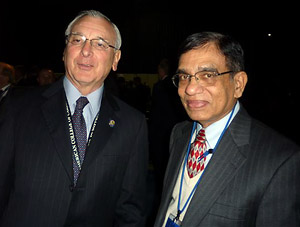
HEALTH LESSONS FROM ACC CONVENTION 2010, PART II

“Could you foretell if there is a heart attack or a stroke in your future?” That is of course, without consulting your astrologer or psychic. Well, the answer is, most likely, “yes.”
During the ‘What is new in the guidelines’ session, a panel of experts discussed the widespread risk for catastrophic heart disease such as heart attacks and sudden deaths. Soon, they will come out with the ‘2010 Guidelines for the Assessment of Cardiovascular Risk in Asymptomatic Adults.’ “Our goal is to establish a foundation for risk assessment in asymptomatic people to target preventive efforts,” said Dr. Phillip Greenland, chair of ACCAHA Guideline Writing Committee. As we all know, cardiovascular disease and cancer consume most of the health care dollars. Hence, the focus is urgently shifting toward prevention.
A number of parameters will be taken into consideration and these include: family history of heart disease, resting ECG, exercise stress tests, myocardial perfusion imaging with nuclear isotopes, echocardiogram, carotid ultrasound studies (helpful to predict future strokes), the newly developed genomic markers, markers of inflammation, measurement of arterial stiffness, coronary calcium scoring by using CT scan (the more calcium you have in the coronary arteries, the more chance for atherosclerosis) and finally, CT coronary angiogram.
“There is a long asymptomatic period during which time patients develop latent CAD, so called ‘silent period’ when sudden deaths can happen,” said Dr. Nanette Wenger. Based on all these parameters, your risk score can be calculated and soon guidelines will be established. The treatments and advice based on these guidelines could save thousands of lives a year by detecting the arterial damage that can lead to heart attacks, angina and heart failure. In other words, prevention is the key for future; this is especially applicable to us, South Asians. Genetic markers are being identified and gene-based treatments capable of averting future heart attacks and other catastrophic diseases are on the horizon. The future looks promising.
“Would you be treated differently if you belong to a minority group?” That was the theme for discussion in the ‘Disparities in Health care’ symposium. Well, the fact is, you could get less than optimal care based on your color, race and ethnic status, according to some of the data presented! This important featured session highlighted the discrepancies in cardiovascular treatment in minorities. Compared to Caucasians, minorities are less likely to get higher quality treatment, especially in the use of life-saving drugs, emergency procedures and implantation of devices. This is a cause for great concern for all of us who belong to a minority group. The population of United States is growing diverse every day and medical personnel need to develop cultural competency in dealing with these different groups. We need to be aware of the variability in disease patterns among them as well. Diabetes is more common in Native and Mexican Americans as well as South Asians, hypertension more in blacks, etc. Communication and education are key factors in overcoming these disparities, so they will not be left out of the best treatment available.
There were numerous other presentations and group discussions, which were useful for the practicing cardiologist. In the ‘JETSTENT’ study, sucking out the clot (rheolytic thrombectomy) before stenting in acute heart attacks was associated with better results. Also, more studies were presented extolling the superiority of drug-eluting (coated) stents versus the old-fashioned bare metal stents.
‘The Health Care Reform: where are we headed’ session generated a lot of interest and some anxiety about the future of health care delivery in the United States. New health care models, perhaps mutually complimentary, such as ‘patient-centered medical home’ in which one physician will be directing your care and ‘hospital-to-home’ model that will reduce the number of hospital readmissions by treating you at home with modern technology once the acute care is over, could become the standard in future. Meaningful EHR (electronic health records) will be implemented. Will these reforms reduce costs while maintaining quality? Well, the road to ‘ideal health care delivery’ is still under construction and nobody is certain if this would be better than the existing pattern.
As the incoming president of ACC, Dr. Ralph Brindis reminded everybody in his inaugural remarks, “Always remember that we are here to make patients with heart disease live longer with less disability and better quality of life, and to be the stewards of our health care dollars.”
This concludes the two part series.
Dr. M.P. Ravindra Nathan is a Brooksville cardiologist and director of the Hernando Heart Clinic.